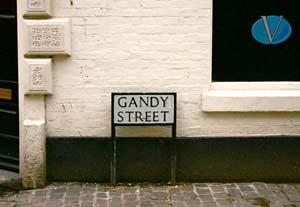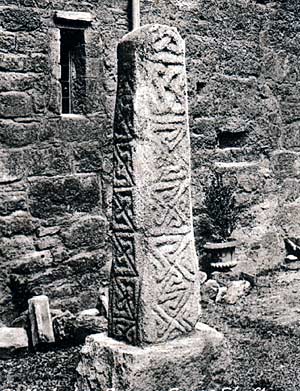
Gandy Street
Last update 8th August 2008
 Many consider Gandy
Street to be one of the most charming, and
interesting streets in Exeter. Lined with bijou gift shops, bistros and
restaurants, it is an essential stop for those visiting Exeter.
Many consider Gandy
Street to be one of the most charming, and
interesting streets in Exeter. Lined with bijou gift shops, bistros and
restaurants, it is an essential stop for those visiting Exeter.
Running off the High Street, at right angles, the line of the street follows the path that the Roman soldiers followed, when patrolling the boundary of their fortress of Isca. The actual street dates from the Saxon, in King Alfred's time and is one of several 'grid like' streets from this period, including Martin's Lane and Catherine Street.
It is recorded that it was called Correstrete in 1265 - this name probably came from the Middle English word for currying, or the curing of leather. It was also known as St Lucie's Lane in 1669. The street was renamed Gandy's Lane and then Gandy Street after Henry Gandy, Mayor of Exeter in 1661 and 1672.
Mayoralty House
Toisa's cross, a 6 ft, late Saxon cross which possibly stood outside the Westgate in 1316, was used to repair the first Exe Bridge in 1603. At the bridge's demolition in 1778 the cross was purchased by a local merchant, William Nation for a guinea, who placed it on the right corner of Gandy Street and High Street to protect the corner of the building from carts passing into Gandy Street. The cross was removed from its corner position and placed in the grounds of St Nicholas Priory in 1916. It is now in the Royal Albert Memorial Museum.
The building protected by the cross, was Topshop until 2007, had been a J Lyons Teashop in the 20th Century, and a tobacconist in 1878. It was a grand building that once belonged to the Mallock family. Roger Mallock was Mayor of Exeter in 1626, and a coat of arms of the Merchant Adventurers of Exeter was once on one the side of a chimney piece while on the other could be found the coat of arms of Elizabeth I. The City Council paid to maintain the house as a Judges residence when they visited the city for the Assize court, although in 1640 the circuit Judges complained about its state, and requested lodgings elsewhere in the city. It was agreed in 1646 that the lodgings for the Judges "shalbe pvided and supplyed by Mr. Ald. Mallock, as heretofore, for the Assizes shortlie to be helde in this Cittie att the charges of the Cittie." Six months later there was a dispute over the rent which was eventually settled at £5 for each Assize. The house was also the residence of the City's Sword bearer and for entertaining by the Chamber. Prior to Roger Mallock's residency, Sir Thomas Bodley founder of the Bodlein Library in Oxford was born in the house in March 1545 and Nicholas Hilliard the miniature portrait artist lived with the Bodleys as a child.
Early printers
Brice's Old Exeter Journal, one of the city's first regular newspapers was published from Gandy Street between 1740 and 1744 by Andrew Brice, and his wife Sarah, who were based at the sign of "The Printing Press". In the 19th century the Exeter and Plymouth Gazzete had an office in the street.
The building on the left entrance to the street, during the 19th century, housed the general store Civet Cat belonging to the Grant brothers, that sold glass, toys and other items. It then became the printers James Townsend, responsible for producing the Western Counties Railway Guide, and the more familiar Timothy Whites in the 20th Century. It is now the Bristol and West Building Society.
Coolings bar was once the Albion Inn, while the Queen's Vaults on the corner of Little Queen Street was part of the Queens Hotel run by Paul Collings, a Spanish born servant of Sir Harry Smith, whom he accompanied in the Peninsular War and at Waterloo. Other lost inns of Gandy Street include the Volunteer Inn, and the City Arms. In former times, Gandy Street offered more mundane shops and offices, including the Exeter Brick Co and a Registrar of Marriages.
New Buildings, is an interesting little arcade in Gandy Street, providing jewellery, ethnic clothing and hairdressing, and is one of those nooks and crannies that gives the area its charm.
The Cavern Club, the Exeter home of Coldplay is just off Gandy Street, while the top end of the street is close to the Royal Albert Memorial Museum and Art Gallery and the Phoenix Arts Centre. It is said that J K Rowling based Diagon Alley in her Harry Potter books on Gandy Street, from her time at Exeter University.
Gandy Street was away from the main source of contaminated water that caused the cholera outbreak of 1832. Even so, there were 10 victims of the disease in the street between July and October .
The Governor of Tasmania
The street was the childhood home of Colonel David Collins RM, the first Judge Advocate in New South Wales (1788-1796) and the first Lieutenant Governor of Tasmania (1804-1810). George P Harris, the first deputy Surveyor General of Tasmania was also brought up in Gandy Street. The two discovered their common childhood home when chatting in a tent in South Australia.
Source: Various sources including Jenkins History of Exeter, Gleanings from the Municipal and Cathedral Records by Cotton and An Account of Exeter's Merchant Adventurers in 16th Century by Cotton and Woollcombe.
 The Gandy Street sign.
The Gandy Street sign.
 Gandy Street looking towads the museum.
Gandy Street looking towads the museum.
 Toisa's Cross pictured at St Nicholas Priory was on the right corner of Gandy Street and the High Street..
Toisa's Cross pictured at St Nicholas Priory was on the right corner of Gandy Street and the High Street..
│ Top of Page │